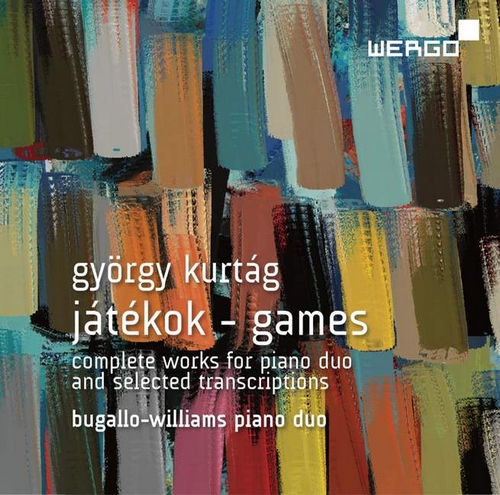Jatekok (Games)
Suite for Four Hands
Transcriptions from Machaut to J S Bach, for 4-hand and 6-hand piano and 2 pianos
The present recording assembles György Kurtág’s complete works for piano duet and two pianos included in the eight published volumes of “Játékok” [Games]. This collection has multiple significations in the artistic life of the composer. He began to write it in 1973 as a pedagogical series. At the time, Kurtág’s activities were equally divided between composing and teaching – both piano and chamber music – at the Franz Liszt Academy of Music in Budapest. In principle, “Játékok” can be seen as a continuation of Béla Bartók’s “Mikrokosmos”, due both to its genre and to the paternal influence that Bartók exerted, from a distance, over that generation of Hungarian composers. Yet the focus of Kurtág’s own piano series is distinct from that of “Mikrokosmos”. “Játékok” is neither an introductory nor progressive course for acquiring piano technique; it rather teaches players to trust what Schönberg called the “infallibility of one’s own fantasy.” In the introduction to the collection, he lays out a series of rhythmic figures (a combination of traditional note-heads and rests, with different types of fermatas) in decreasing order. The actual temporal proportion of the figures may vary, depending on the context. In the process of having to decide how the music will unfold in time, the performer must carefully listen to every note, paying attention to its dynamic, articulation, register, relative suggested length, and position on the page. The result is an enhanced awareness of sound and, through the creative process of finding an interpretation, also of time and form. Kurtág furthermore incorporates palms, fists, and forearms as a means of exploring the keyboard.
In his transcriptions, Kurtág also embraces music from Machaut to J. S. Bach, passing through Orlando di Lasso, Girolamo Frescobaldi, Heinrich Schütz, and Henry Purcell. The transcriptions in this volume bear no less weight than Kurtág’s original compositions; they dialogue with each other. The transcriptions exploit the particular transparency of the piano – the richness of orchestral color makes us sometimes forget the incomparable monochromatic beauty of this instrument.














